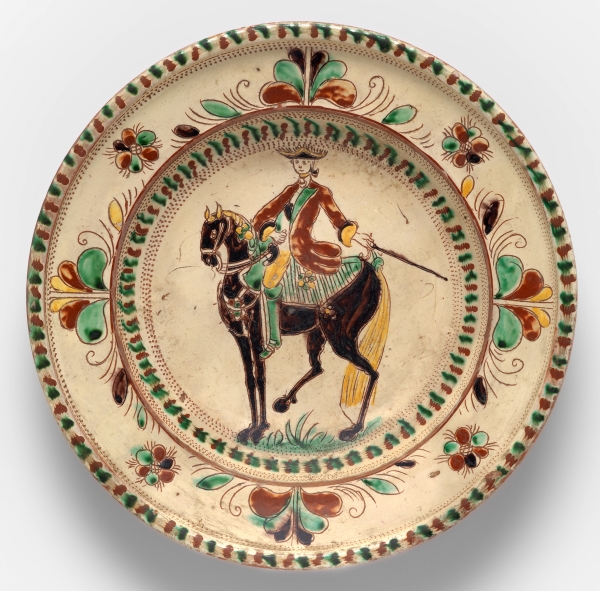
Plate with a mounted dragoon from the Musée Ariana, Geneva (MAG AR931)
Andreas Heege und Andreas Kistler 2019
It was only after the entire Bäriswil canon of motifs and shapes had become known that it was possible to isolate and closely examine a small but highly characteristic group of vessels, subsequently described as originating from the “Bäriswil region”. In all likelihood they were made in the Canton of Bern and in the region of Bäriswil, though we have not been able to identify the actual manufacturer or place of production.
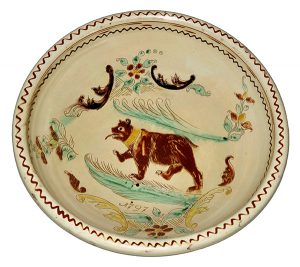
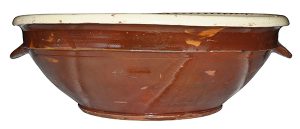
A small number had Bäriswil shapes and were decorated with typical Bäriswil motifs and decorative elements but with Langnau incising and slip-trailing supplemented by chattered and combed decorations and Langnau motifs (Heege/Kistler/Thut 2011, 177-184 “Bärisnau”).
Chattered and combed decoration, in particular, is not otherwise found on pottery from Bäriswil, nor does combed decoration usually occur on Langnau pottery. A large number of motifs, however, are so closely related to the Bäriswil canon of motifs that we must assume that the potters who made these wares were very familiar with the Bäriswil workshops’ output and were used to producing these designs on a daily basis. This would have only been feasible if their workshops were also located in Bäriswil or at least in the Bäriswil region. The nearest locations with potters’ workshops were Hängelen, Jegenstorf, Urtenen and Münchenbuchsee. The ties with the Häberli potters in Hängelen appear to have been particularly close (Heege/Spycher/Kistler 2019), but it has not yet been possible to find any conclusive evidence to show that this group of vessels were indeed produced there.

The oldest piece in this group, which today comprises 22 vessels nationwide, is a bowl bearing the date 1778 with a typical Bäriswil bird in its well (MAG R166). The closest parallels to this motif from Bäriswil date from the period between 1770 and c. 1782 (BHM 5478; MAHN AA1833; MAHN AA2025; GNM H.G.8311). The other decorative elements, including cross-hatching and early rocaille designs, also date from the same period. Monochrome red slip on the outside was practically never seen on decorated Langnau vessels but was quite commonly found on Heimberg pottery from the 1780s.
The plate with a mounted dragoon (MAG AR931) can be classed as a very close parallel to the 1778 bowl. Both the combed and chattered decorations and the coat of red slip on the outside are a match. Combed decoration is not known from Langnau or Heimberg production from this period. The dragoon, presenting his sabre, is reminiscent of the Bäriswil dragoons (BHM 32661), both formally and in his seated posture. The horse is unusually stiff in its pose but has its right hind leg raised in the same way as the Bäriswil equine depictions, as if it was about to amble or trot away. Provided it is even permissible to project the chronological timeframes of individual Bäriswil motifs onto this group of vessels, the plate in question probably dates from a little later. It bears so-called “Foliage 1”-type decoration, which is otherwise mainly dated to around 1788.
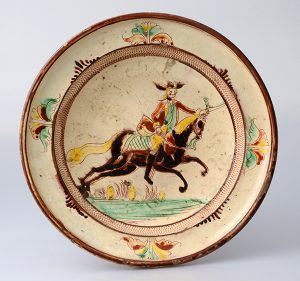

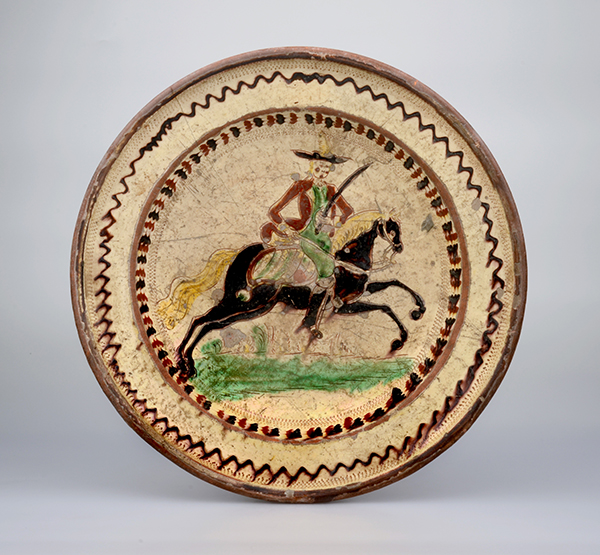
Another close parallel is a plate with a dragoon from the Bernisches Historisches Museum (Bern Historical Museum) (BHM 17579). Two further plates, one from the Bernisches Historisches Museum (BHM 2875), the other from the Musée cantonal d’archéologie et d’histoire Lausanne (Lausanne Museum of Archaeology and History) (MCAHL PM-4327), show a dragoon galloping off towards the right; one is brandishing a pistol, the other a sabre. The range of soldiers’ depictions in this group of vessels also includes two foot soldiers presenting their arms (cf. Heege/Kistler/Thut 2011, Fig. 175 and SNM LM-3203). The large number of depictions connected to the military is another aspect that links this group of vessels to Bäriswil rather than Langnau, as military motifs and depictions of dragoons are highly unusual in Langnau and the Emmental valley.


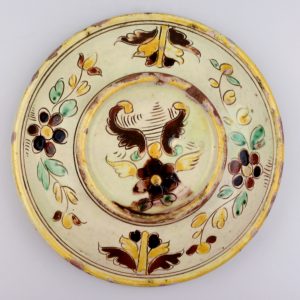
Given the numerous parallels between the vessels in this group and those produced in Bäriswil it should come as no surprise that it also contains bowls that look like miniature versions of tureens with external lid seatings and cap lids (MAG N231). Such bowls are known to have been made in Bäriswil from around 1758 to c. 1780/1782, with one piece even dating from the beginning of the following phase of production, i.e. from c. 1788 to 1793 (cf. Heege/Kistler/Thut 2011, Figs 116 and 117; MKW 253). After that period, tureens had flanged lids. While the lid or cover of the example shown here is consistent with the Bäriswil decorative range, the motifs on the bottom part include a large rosette. This motif is regularly found on Langnau wares from the early 18th to the early 19th centuries, but not on Bäriswil vessels (Heege/Kistler 2017b, 556-558, Fig. 676). It is also obvious from a stylistic point of view that this unusual bottom part of a bowl with external lid seating and cap lid was made in Langnau. We can assume that the broken lid of a Langnau bowl was replaced sometime around 1780 with a new lid from a pottery in and around Bäriswil, which fitted perfectly.
Translation Sandy Haemmerle
References
Heege/Kistler/Thut 2011
Andreas Heege/Andreas Kistler/Walter Thut, Keramik aus Bäriswil. Zur Geschichte einer bedeutenden Landhafnerei im Kanton Bern (Schriften des Bernischen Historischen Museums 10), Bern 2011, 177-184.
Heege/Kistler 2017a
Andreas Heege/Andreas Kistler, Poteries décorées de Suisse alémanique, 17e-19e siècles – Collections du Musée Ariana, Genève – Keramik der Deutschschweiz, 17.-19. Jahrhundert – Die Sammlung des Musée Ariana, Genf, Mailand 2017, 354-361.
Heege/Kistler 2017b
Andreas Heege/Andreas Kistler, Keramik aus Langnau. Zur Geschichte der bedeutendsten Landhafnerei im Kanton Bern (Schriften des Bernischen Historischen Museums 13), Bern 2017.
Heege/Spycher/Kistler 2020
Andreas Heege/Alfred Spycher/Andreas Kistler, Die Hafner von Hängelen und das Rätsel der Bäriswiler Kachelöfen, in: Gemeindebuch Krauchthal, 2020, 173-256.

